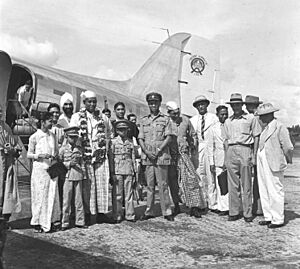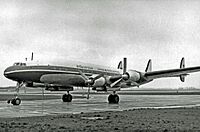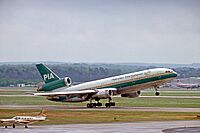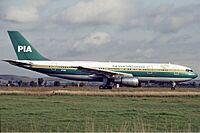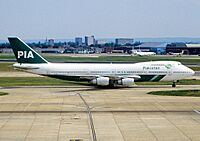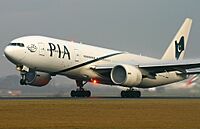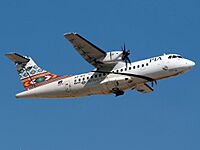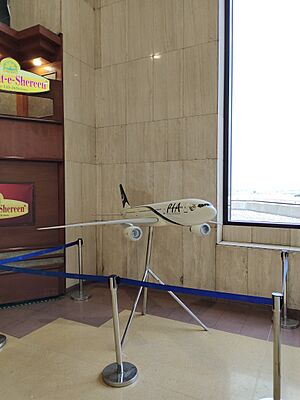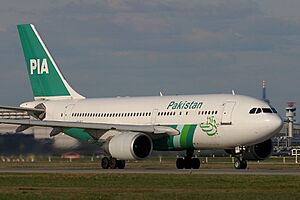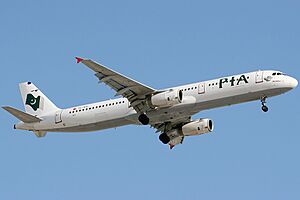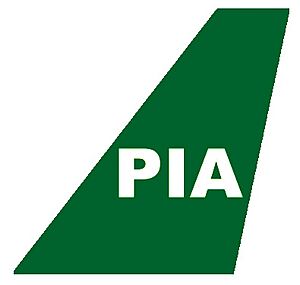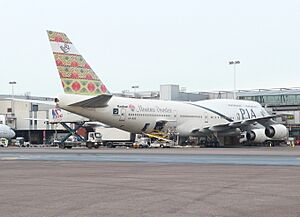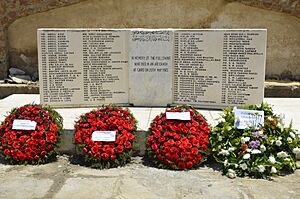Pakistan International Airlines facts for kids

Pakistan International Airlines Boeing 777 with new Euro-White hybrid livery.
|
|
| Founded | 29 October 1946 (as Orient Airways) |
|---|---|
| Commenced operations | 11 March 1955 (as Pakistan International Airlines) |
| Hubs | Karachi |
| Secondary hubs | |
| Frequent-flyer program | Awards Plus |
| Subsidiaries | Roosevelt Hotel (New York) |
| Fleet size | 43 (planned) |
| Destinations | 48 (2025) |
| Parent company |
|
| Headquarters | Jinnah International Airport, Karachi |
| Key people | |
| Revenue | |
| Operating income | |
| Net income | |
| Total assets | |
| Employees | 6,700 (2025) |
Pakistan International Airlines (PIA) is the main airline of Pakistan. It's like the country's official airline. Its main base, called a hub, is at Jinnah International Airport in Karachi. PIA also flies from other important airports in Islamabad and Lahore.
PIA started on October 29, 1946, as Orient Airways. It was founded by Mirza Ahmad Ispahani and Adamjee Haji Dawood. The airline first operated in Calcutta, British India. After Pakistan became independent in 1947, Orient Airways moved its operations there. Later, it became Pakistan International Airlines. In 1955, PIA began flying internationally to London. In 1964, it was the first airline from a non-Communist country to fly to China. PIA even helped start Emirates airline in 1985. In 2004, PIA was the first to use the Boeing 777-200LR plane. In 2005, a PIA Boeing 777-200LR flew the world's longest nonstop commercial flight. It flew for 22 hours and 22 minutes from Hong Kong to London.
PIA is Pakistan's biggest airline. It has a fleet of 32 aircraft. The airline has a program for frequent flyers called Awards +Plus. It is not part of any airline alliance. PIA operates almost 50 flights daily. It serves 20 places within Pakistan and 28 places around the world. These destinations are in Asia, Europe, the Middle East, and North America. The Secretary to the Government of Pakistan for Aviation manages the airline.
PIA also owns some hotels, like the Sofitel Paris, The Scribe Hotel in Paris, and The Roosevelt Hotel in New York City. The Roosevelt Hotel is now used as a place for people who need shelter.
In 2020, the Government of Pakistan reported that PIA faced many challenges. After some successful leaders left, the airline started losing money. Its assets decreased, and problems with discipline grew. Planes that could fly were stopped, and repairable equipment was ignored.
On June 30, 2020, the European Union Aviation Safety Agency (EASA) stopped PIA from flying in European skies. This was because EASA found that PIA could not properly check its planes and operations. The ban was lifted on November 29, 2024. This allowed PIA to fly between Pakistan and Europe, but not the UK. The UK lifted its ban on July 16, 2025.
Contents
- How PIA Started
- After Independence
- How PIA is Managed
- Where PIA Flies
- PIA's Aircraft Fleet
- Plane Designs (Livery)
- Services Offered
- Cargo Flights
- Sponsorships and Community Work
- Special Services
- Awards and Recognition
- Accidents and Incidents
- See also
How PIA Started
Pakistan International Airlines began before Pakistan became an independent country in 1947. In the 1930s, Imperial Airways flew long routes. They used many small airports across Africa and Asia. The Handley Page H.P.42 aircraft was a big success for Imperial Airways. It was made to fly from places that didn't have proper runways.
In 1945, Muhammed Ali Jinnah, who founded Pakistan, saw the need for a national airline. He asked wealthy businessmen Mirza Ahmad Ispahani and Adamjee Haji Dawood for money. So, a new airline called Orient Airways was registered in Kolkata (then Calcutta) on October 23, 1946. Orient became the first and only Muslim-owned airline in British India.
In February 1947, Orient Airways bought three Douglas DC-3 planes. They got a license to fly in May of that year. The airline started flying on June 30, 1947. It offered flights in British India from Calcutta to Sittwe and Rangoon (now Yangon).
After Independence
On August 14, 1947, Pakistan became independent. Orient Airways started helping the new country. The airline was given the job of flying between East and West Pakistan. By 1949, Orient bought three Convair CV-240s. These planes flew the Karachi-Delhi-Kolkata-Dhaka route. Orient became the first Asian airline to use Convair planes.
The 1950s: A New Beginning
Orient's passenger numbers went down until 1953. This was because other airlines started flying on its routes. To help, the Pakistani government began supporting Orient. In 1952, the government bought three Lockheed L-1049 Super Constellation planes. These planes were for a new airline called Pakistan International Airlines (PIA). PIA was part of Pakistan's Civil Aviation Authority. Its job was to operate and maintain the new Lockheed planes.
The government merged Orient Airways with Pakistan International Airlines on October 1, 1953. The government took control of the airline's money. Orient's operations and ground equipment were combined with PIA's planes. Orient Airways continued to fly under its own name for a few more years.
Pakistan's Ministry of Defence took over operations in early 1954. The chairman of Orient Airways became PIA's CEO. Foreign experts were brought in to help restart the airline. On June 7, 1954, Orient Airways started nonstop flights between East and West Pakistan. They flew from Karachi to Dhaka using PIA's Lockheed planes. The government helped pay for this route. This made it affordable for many Pakistanis to fly. The airline also added new routes within Pakistan.
On March 11, 1955, Orient Airways and Pakistan International Airlines officially merged. This created the Pakistan International Airlines Corporation. The new PIA had a fleet of three L-I049C Super Constellations, two Convair CV-240s, and eleven DC-3s.
The new airline also started its first international route. It flew from Karachi to London Heathrow Airport. This flight stopped in Cairo and Rome. PIA used its new Lockheed L-1049C Super Constellations for this route. It continued to use DC-3s for flights within Pakistan. In 1955, PIA carried 113,165 passengers. This was 50% more than in 1954.
In May 1956, PIA ordered five Vickers Viscount 815s. The airline also partnered with PanAm in 1956 to train its staff. By 1957–1958, passenger numbers grew to 208,000. This led to buying two more Lockheed Super Constellations. In 1959, Air Marshal Nur Khan became PIA's managing director. This started a very successful time for the airline.
The 1960s: Jet Age and Expansion
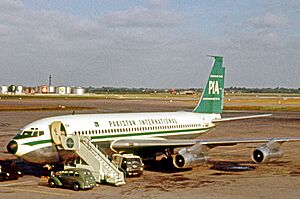
In February 1960, PIA rented a Boeing 707 from Pan American Airlines. On March 7, 1960, it started using this plane on the Karachi-London route. This made PIA the second Asian airline to use a jet plane. By the end of 1960, PIA made a profit for the first time.
With new planes, the airline started its first flight across the Atlantic Ocean. This route, Karachi-New York JFK, began on May 5, 1961. In 1961, PIA ordered three Boeing 720s, which arrived in 1962. On January 2, 1962, a PIA Boeing 720B set a world speed record for a commercial flight. It flew at 938.78 km/h (582.98 mph). This record still stands today. Fokker F27 Friendships and Sikorsky helicopters were also ordered and delivered in 1963. The helicopters flew to 20 towns in East Pakistan until 1966.
The helicopters were retired in 1966. Fokker F27 aircraft then served a smaller network of eight cities. On April 29, 1964, PIA started flying the Dhaka-Guangzhou-Shanghai route. This made it the first airline from a non-communist country to fly to China. On May 10, 1964, PIA became the first non-Soviet airline to offer flights to Europe via Moscow.
During the Indo-Pakistani War of 1965, the Pakistani Armed Forces used PIA's planes for moving supplies and troops. The Viscounts were replaced by four Hawker Siddeley Tridents in 1966.
PIA's routes grew quickly in the mid to late 1960s. Dhahran was added in 1962, and Cairo services restarted. In 1966, Paris, Istanbul, Baghdad, Kuwait, Jeddah, and Nairobi were added. Bangkok was added in 1967, and Manila, Tokyo, and Damascus in 1969.
In May 1967, Air Marshal Asghar Khan announced that PIA was the fifth most profitable airline in the world. It carried one million passengers each year. In July 1967, Asghar Khan announced plans to build small hotels across Pakistan. These hotels were completed in 1970.
The 1970s: New Aircraft and Global Reach
On December 3, 1971, a person tried to hijack a PIA flight from Paris to Karachi. French security stopped the attempt. Flights to New York City restarted in May 1972. They included a stop in Europe. PIA added Tripoli to its network in 1972. PIA also signed an agreement with Yugoslav airline JAT in 1972.
PIA bought McDonnell Douglas DC-10s in 1973. These planes replaced its older Boeing 707-300s. Nur Khan became PIA executive again in 1974. In 1974, PIA started Pakistan International Cargo. This offered air freight and cargo services.
In the late 1970s, PIA added Boeing 747s to its fleet. The first two were rented from TAP Air Portugal in 1976. By 1976–77, PIA carried 2.2 million passengers. This was much higher than in 1972–73. On January 20, 1978, a PIA Fokker 27 was hijacked on its way to Karachi from Sukkur.
PIA started helping other airlines with technical and management support. These included Air China, Air Malta, and Emirates. A part of PIA also started managing hotels in the United Arab Emirates.
The 1980s: Continued Growth
The 1980s saw PIA continue to grow. The decade began with a new cargo handling center at Karachi airport. Duty-free shops were opened. The airline also introduced its first Airbus A300B4-200 aircraft. In 1981, PIA had almost 24,000 employees. Even after reducing staff, PIA had many employees for its number of planes. PIA made its highest profits ever in 1981-82 and again in 1983-84.
In 1984, the airline started the Night Coach service. This was a cheaper option for domestic flights. Later, PIA Planetariums opened in Karachi, Lahore, and Peshawar. These planetariums showed retired PIA planes. PIA made more profits in 1984–85.
In June 1985, PIA was the first Asian airline to use the Boeing 737-300 aircraft. PIA also helped set up Emirates airline in 1985. It provided technical help and rented planes to Emirates. In late 1987 and early 1988, flights to Malé, Manchester, and Toronto began.
The 1990s: Challenges and New Routes
PIA started losing money in the 1990s. This was due to pilot strikes, problems with suppliers, too many staff, and political issues. In 1990, First Officer Maliha Sami became PIA's first female pilot. In June 1991, PIA received its first of six Airbus A310-300s. With these new planes, the airline started flights to Tashkent in 1992 and to Zürich in 1993.
In March 1993, AVM Farooq Umar became the airline's managing director. In 1993, an agreement allowed more flights between Karachi and Dubai. Also, 12 private airlines could now fly within Pakistan. These changes put pressure on PIA's finances. However, PIA launched six new routes to the Persian Gulf and CIS countries. It also started a tourist flight over the Karakoram Mountains in 1994. Non-stop flights from Lahore and Islamabad to JFK and Canada began. PIA added Jakarta, Fujairah, Baku, and Al-Ain to its network in 1994. PIA also joined three major flight booking systems.
A Tupolev Tu-154 plane was rented briefly in 1996 to handle more passengers. Flights to Beirut restarted that year but stopped a few years later. In 1999, PIA rented five Boeing 747–300 planes from Cathay Pacific. These replaced its Boeing 747-200M fleet. The planes were painted with a new design.
The 2000s: Modernization and Records
The War in Afghanistan after September 11, 2001, affected PIA. Afghan airspace was closed. But after new management took over in April 2001, the airline became profitable again. Costs went down, and the airline made more money.
In July 2002, PIA bought six Boeing 747–300 planes from Cathay Pacific. In October 2002, PIA ordered eight Boeing 777 aircraft. This order included three different types of 777s. PIA was the first customer to order the Boeing 777-200LR.
Boeing delivered the first 777-200ER to PIA in January 2004. PIA introduced a new paint design for these planes. PIA also rented six more Airbus A310-300 planes. On November 3, 2005, PIA ordered seven ATR 42-500 aircraft. These replaced its older Fokker F27 Friendships. On November 10, 2005, PIA used the 777-200LR to fly the world's longest commercial flight. It flew over 21,000 kilometers from Hong Kong to London in 22 hours and 22 minutes. This record still stands. In 2005, Ayesha Rabia Naveed became the first Pakistani woman to captain a scheduled commercial flight. The next year, she captained a flight with an all-woman crew. On December 23, 2006, PIA received its first Boeing 777-300ER. The rest arrived in January 2007.
On February 25, 2006, Boeing delivered its first 777-200LR to PIA. ATR delivered two ATR 42s to PIA in May and December 2006. After this, the airline stopped using military planes for passenger services in northern Pakistan.
PIA started offering non-stop flights from Toronto to Karachi, Islamabad, and Lahore on March 3, 2006. This was possible with the new long-range 777 aircraft. PIA had also planned non-stop flights to New York City and other US cities. However, US authorities did not allow this due to security concerns after 9/11.
A PIA flight from Multan crashed in July 2006, killing 45 people. A government investigation blamed old aircraft for the crash. Houston services also ended in 2006. On March 5, 2007, the European Commission banned most of PIA's fleet from flying to Europe. This was due to safety concerns about its older planes. The Boeing 777s were allowed to fly. PIA said the ban was unfair.
The ban on some aircraft was lifted after four months on July 5, 2007. This happened after an inspection by the European Union Air Safety Administration. On November 29, 2007, the EU completely removed the ban. All of PIA's planes were allowed to fly to Europe.
The 2010s: Financial Struggles and Changes
In 2010, PIA changed its plane design. The tail now had a larger Pakistan national flag. The words "Pakistan International" were added in gold. By 2011, PIA started losing money again and needed government help.
In 2014, PIA rented four Boeing 737-800s. PIA also added Airbus A320 aircraft to its fleet. In 2015, PIA stopped using its Boeing 747-300s after 16 years of service.
In early 2016, PIA flights were stopped for a week. Employees protested against the airline being sold to private companies. In August 2016, PIA launched a new "Premier Service" for flights to London. It used an Airbus A330-300 rented from SriLankan Airlines. This service ended after six months. By the end of 2016, the airline had $3 billion in debt.
In January 2017, PIA removed all Airbus A310-300s from its fleet. PIA's service to New York ended in October 2017. This was due to rules that prevented non-stop flights from Pakistan to the US. Toronto became PIA's only destination in North America.
In 2017, PIA changed its booking system. By the end of 2018, the airline had $3.3 billion in debt. It needed government help to keep operating. PIA launched new routes in 2019 that were profitable. It also stopped six routes that were losing money. In April 2019, PIA said its income almost covered its costs. In August 2019, PIA laid off 1,000 employees. By the end of 2019, PIA's income increased by 41%. This was due to stopping unprofitable routes and using its planes more efficiently.
The 2020s: Recent Events
During the COVID-19 pandemic, PIA operated a special flight from Lahore to Melbourne, Australia. This was the first time in its history.
On May 22, 2020, a PIA Airbus A320-214 crashed near Karachi airport. The flight was from Lahore. Flight PK8303 had 99 people on board. 97 people died, and two passengers survived. The crash happened during landing. The plane's engines were damaged, and it tried to fly again but lost power. The final report said human error and not following rules were the main reasons.
The International Air Transport Association (IATA) expressed concerns about Pakistan's aviation safety checks.
In November 2020, PIA closed its courier service, SpeedEx. It laid off 320 employees. In December 2020, PIA announced plans to reduce its employees by half. It also moved its engineering part, Precision Engineering Complex (PEC), to the Pakistan Air Force.
Pilot Safety Concerns
On June 24, 2020, after the Flight 8303 crash, Pakistan's aviation minister said that some pilots' licenses were not genuine. PIA then stopped 150 of its pilots from flying. Later, seven pilots' jobs were ended.
On June 30, the European Union Aviation Safety Agency (EASA) banned PIA from flying in European airspace for six months. This was due to safety issues. On July 9, 2020, the United States also banned the airline. The United Kingdom banned PIA as well.
On November 29, 2024, EASA lifted the ban on PIA. This was because of improvements in Pakistan's aviation safety oversight. PIA announced that flights to Europe would restart, with a flight to Paris on January 10, 2025. On July 16, 2025, the UK's Civil Aviation Authority also lifted its ban on PIA. PIA plans to restart flights to the UK.
Flight Cancellations
In late 2023, PIA had to cancel many flights. This was because it had not paid its fuel bills. The state-owned Pakistan State Oil stopped providing fuel to PIA. This happened after PIA's request for more government money was denied.
In late December 2023, the government announced a plan to sell the airline to private owners.
Expanding to the Middle East
On January 6, 2025, PIA announced it would fly to more places in the Middle East. It would use its Boeing 777 and Airbus A320 planes. From January 20, 2025, PIA started two weekly flights between Sialkot and Bahrain. Other new flights included Lahore to Dammam and Lahore to Kuwait. PIA also introduced weekly flights from Faisalabad to Jeddah and from Sialkot to Doha, Qatar.
How PIA is Managed
Structure of the Airline

Pakistan International Airlines Corporation Limited (PIACL) is mostly owned by the Government of Pakistan (86%). The rest (14%) is owned by private shareholders. The airline is managed by the Aviation Division. It is led by a president and chief executive officer, along with a board of directors.
The board has nine independent members. It has four smaller groups: an Audit Committee, Brand and Advertising Committee, Finance Committee, and Human Resource Committee. The president and CEO lead the staff who run the airline. PIA's main office is in Karachi. It also has smaller offices in other cities in Pakistan.
Seven of PIA's ten departments are in Islamabad. These include Marketing, Reservations, and Human Resources. The other three departments are in Karachi: finance, engineering, and the situation room.
Selling Parts of the Airline
In the late 1990s, the Government of Pakistan planned to sell parts of the airline. This was because PIA kept losing money. But these plans were never carried out. However, some non-airline businesses, like catering and ground handling, started to become separate companies. In 1997, Pakistan asked the International Finance (IFC) for advice on how to restructure and sell PIA. But no agreement was reached. Despite many plans, the government decided not to sell PIA in 2009.
In 2013, the government again planned to sell the airline. This plan was stopped due to protests by airline workers. In 2018, the new government decided not to sell PIA. Instead, it aimed to make the airline profitable by changing its top management.
On February 6, 2024, the government decided to split PIA into two parts. This was to make it more attractive to investors. These parts were called TopCo and HoldCo. TopCo got the main airline functions, like engineering and ground handling. HoldCo got other properties and departments.
On June 4, 2024, the government chose 6 companies to bid for buying PIA.
Money and Operations
In 2011, PIA started losing money again and needed government help. By the end of 2016, the airline had $3 billion in debt. By the end of 2018, this debt grew to $3.3 billion. So, it needed more government money to keep going. In April 2019, PIA said its income almost covered its costs. An audit in September 2019 showed that PIA flew 46 empty flights between 2016 and 2017. This caused a loss of $1.1 million. Also, 36 Hajj flights flew without any passengers. By the end of 2019, PIA's income increased by 41%. This was because it stopped unprofitable routes and used its cargo space much more.
PIA faces many challenges to make a profit. PIA, along with Etihad, used to be one of the cheapest airlines in the Middle East. Pakistan faces a lot of competition from Middle East airlines. These airlines fly many daily flights to major cities in Pakistan. For example, an agreement with the UAE allows their airlines unlimited flights to Karachi. Emirates airline alone flies up to seven daily flights to Karachi from Dubai. PIA also stopped flying profitable routes to the US. This was because US rules required costly stops in Europe for immigration checks. This made PIA's flights much longer than those of Middle Eastern airlines. Also, the number of employees and overall management issues create more challenges. However, in August 2019, PIA laid off 1,000 employees.
| Year | Revenue (PKR million) | Net income (PKR million) | Passenger load factor (%) | Revenue passengers (million) | Employees (average) |
|---|---|---|---|---|---|
| 2005 | |||||
| 2006 | |||||
| 2007 | |||||
| 2008 | |||||
| 2009 | |||||
| 2010 | |||||
| 2011 | |||||
| 2012 | |||||
| 2013 | 70 | ||||
| 2014 | |||||
| 2015 | |||||
| 2016 | N/A | ||||
| 2017 | |||||
| 2018 | |||||
| 2019 | |||||
| 2020 | |||||
| 2021 | |||||
| 2022 | |||||
| 2023 |
Where PIA Flies
As of November 2019, PIA flies to 19 places within Pakistan. It also flies to 28 international places in 20 countries. These countries are in Asia, the Middle East, Europe, and North America.
PIA has agreements with other airlines. These are called Interline agreements and codeshares. This means PIA can offer flights to 102 international places in 40 countries.
Main Airports (Hubs)
PIA's main airports are Jinnah International Airport in Karachi, Allama Iqbal International Airport in Lahore, and Islamabad International Airport. Karachi is PIA’s primary hub. Islamabad and Lahore are secondary hubs.
Partner Airlines
PIA has agreements to share flights (codeshare agreements) with these airlines:
- China Southern Airlines
- Etihad Airways
- Kenya Airways
- Thai Airways International
- Turkish Airlines
PIA also has agreements to connect flights (interline agreements) with these airlines:
- Air Canada
- Air China
- Air France
- Batik Air Malaysia
- Flydubai
- Flynas
- Malaysia Airlines
- Scandinavian Airlines
- Swiss International Air Lines
- WestJet
For cargo, PIA has special agreements with these airlines:
PIA's Aircraft Fleet
Current Aircraft
As of July 2025, Pakistan International Airlines uses these aircraft:
| Aircraft | In service | Orders | Notes |
|---|---|---|---|
| ATR 42-500 | 3 | — | |
| Airbus A320-200 | 17 | 3 | |
| Boeing 777-200ER | 6 | — | |
| Boeing 777-200LR | 2 | 2 | Launch customer |
| Boeing 777-300ER | 4 | 6 | On order |
| Total | 32 | 11 |
In May 1994, PIA had 47 aircraft (45 owned).
Past Aircraft
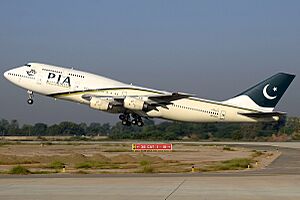
PIA has used many different types of aircraft over the years. Some of these include:
| Aircraft | Total | Introduced | Retired | Notes |
|---|---|---|---|---|
| Airbus A300B4-200 | 10 | 1980 | 2005 | |
| 1 | 1986 | 1992 | Crashed as flight PK268 | |
| Airbus A310-300 | 12 | 1991 | 2016 | |
| Airbus A320-200 | 1 | 2014 | 2020 | Crashed as flight PK8303 |
| Airbus A321-200 | 2 | 2006 | 2007 | |
| Airbus A330-300 | 1 | 2016 | 2017 | |
| ATR 42-500 | 1 | 2007 | 2016 | Crashed as flight PK661 |
| ATR 72-500 | 3 | 2015 | 2020 | |
| Boeing 707-320C | 12 | 1960 | 1999 | |
| 1 | 1979 | Crashed as flight PK740 | ||
| Boeing 720B | 8 | 1962 | 1986 | |
| 1 | 1965 | Crashed as flight PK705 | ||
| Boeing 737-300 | 8 | 1985 | 2014 | |
| Boeing 737-400 | 2 | 2004 | 2005 | |
| Boeing 737-800 | 4 | 2014 | 2015 | |
| Boeing 747-200B | 6 | 1976 | 2005 | |
| Boeing 747-200B Combi | 2 | 1979 | 2011 | |
| Boeing 747-300 | 6 | 1999 | 2015 | Bought from Cathay Pacific |
| Convair CV-240 | 4 | 1947 | 1959 | |
| de Havilland Canada DHC-6 Twin Otter | 8 | 1970 | 2001 | |
| Douglas DC-3 | 15 | 1947 | 1967 | |
| Douglas DC-8-21F | 1 | 1977 | 1978 | |
| Douglas DC-8-61CF | 1 | 1977 | 1978 | |
| Fokker F27-200 Friendship | 22 | 1961 | 2006 | |
| 1 | 1989 | Missing as flight PK404 | ||
| 1 | 2006 | Crashed as flight PK688 | ||
| Fokker F27-400 Friendship | 1 | 1961 | 2003 | |
| Fokker F27-600 Friendship | 5 | 1966 | 1986 | |
| Hiller UH-12E4 | 1 | 1963 | 1971 | |
| Hawker Siddeley Trident 1E | 4 | 1966 | 1970 | |
| Lockheed L-100-382B-4C Hercules | 2 | 1966 | 1966 | |
| Lockheed L-1049C Super Constellation | 3 | 1954 | 1969 | |
| Lockheed L-1049H Super Constellation | 2 | 1958 | 1969 | |
| McDonnell Douglas DC-10-30 | 5 | 1974 | 1986 | |
| Mil Mi-8 MTV-1 | 1 | 1995 | 1997 | |
| Sikorsky S-61N | 3 | 1963 | 1967 | |
| 1 | 1966 | Crashed as flight PK17 | ||
| Tupolev Tu-154 | 4 | 1996 | 1997 | |
| Vickers Viscount 815 | 5 | 1956 | 1966 |
Plane Designs (Livery)
In December 2003, PIA introduced a new look for its planes. The front of the plane was white, and the back was beige. A dark green stripe separated these colors. The tail was white with "PIA" in dark green letters. The word "Pakistan" was added to the front of the plane. The PIA logo in Urdu was placed behind the cockpit. However, after some feedback, the design was changed. The tail logo became a flowing Pakistan flag on a beige background. The "Pakistan" titles were removed, and "PIA" was made larger on the plane's body.
In early 2006, the airline launched four new tail designs. These tails showed the four provinces of Pakistan: Sindh, Punjab, Khyber Pakhtunkhwa, and Balochistan. The designs promoted the cultures of these provinces. For example, the "Frontier" tail showed a "Phulkari" (flowering) pattern. The "Punjab" tail was inspired by tile decorations. The "Balochistan" tail showed patterns from local carpets. The "Sindh" tail used blue and white floral patterns. In 2009, the management stopped using these provincial tails because they were too expensive.
PIA launched its newest design in April 2010. An Airbus A310, Boeing 777–200, and Boeing 747–300 were the first to get this new look. The design had a green and gold stripe along the bottom of the plane. The front was white, and the back was off-white/beige. The tail had a large wavy Pakistan flag in dark green. "PIA" was written in large dark green letters on the front. Below it, "Pakistan" was written in gold.
In July 2014, PIA added a "crescent and star" design to the plane engines. In 2015, to celebrate sixty years of service, the 1960s design was put on some Airbus A320s and one Boeing 777-200ER.
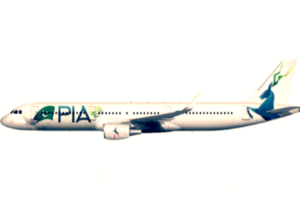
In April 2018, PIA launched a new brand identity. It added a picture of the Markhor to its planes. The Markhor is Pakistan's national animal. It was chosen to show PIA's strong nature. The tail had a leaping Markhor with long horns. This animal is found only in Pakistan. The idea was to make PIA a truly international brand. The font of the PIA logo was also changed. The airline's slogan became "We Fly at the Right Attitude". The first plane with this new design was shown on May 12, 2018. However, the Supreme Court of Pakistan stopped the re-branding. This was due to concerns about spending money on it while staff salaries were delayed. The Supreme Court ordered PIA to keep the flag on the tail. The re-branding was later stopped completely.
Currently, PIA uses a mix of designs. The plane body is white. It has a gold Urdu logo near the front doors and on the engines. The tail has the flag design. The English "PIA" and "Pakistan International" titles are in dark green. The "Pakistan" title on the belly is also dark green. Five Boeing 777s and three A320s currently have this mixed design.
Services Offered
Food and Drinks
PIA Catering provides most of the meals for flights from Islamabad and Karachi. It can make 15,000 meals for passengers every day. In 2006, Singapore Airport Terminal Services (SATS) managed the food services. This agreement ended in 2011, and PIA now manages it itself. As of April 2019, PIA and McDonald's signed an agreement for airline catering. PIA Catering offers special meals for different diets and religious needs. No alcoholic beverages or pork are served on board due to Islamic dietary laws.
Premier Service
PIA Premier was a special luxury service launched on August 14, 2016. An Airbus A330 plane was rented from SriLankan Airlines for this service. There were six weekly flights to London. However, it was stopped because it lost money.
Entertainment on Board
Pakistan International Airlines was the first international airline to show movies on board in 1962.
Internet on Board
In January 2017, the airline started testing an internet system on some domestic flights. This system lets passengers use their own phones or tablets to watch movies, listen to music, and view TV shows. Boeing 777 flights have personal screens with movies, music, and TV. These screens also show a map of the flight. Some A320s have screens that drop down to show a map and flight information.
Engineering and Ground Handling
The Precision Engineering Complex (PEC) has facilities for:
- Binocular Assembly
- Calibration Facility
- Glass Fibre Composite Manufacturing
- Investment Casting Facility
- Machine Shop
- Material Testing Laboratory
- Non Destructive Testing Facility
- Optics
- Printed Circuit Boards (PCB)
- Plating Facilities
- Packaging Plant
- Shot Peening
PIA also provides ground handling services for other airlines. This means they help with things like loading bags and guiding planes on the ground. Some of these airlines are:
- Air China
- China Southern Airlines
- Gulf Air
- Oman Air
- Qatar Airways
- Saudia
- SriLankan Airlines
- Uzbekistan Airways
Cargo Flights
PIA has a system for delivering cargo within Pakistan. PIA Cargo transports goods across Pakistan and to other countries. These goods include food, textiles, paper, lab equipment, and mail.
In the early 1970s, PIA had a service called Air Express. It delivered documents and parcels within Pakistan. In 1974, PIA started a special cargo division. It used two Boeing 707-320C planes. This division was called Pakistan International Cargo. The airline flew cargo to the Middle East and Europe. These operations ended in the late 1990s. From 2004 to 2007, the airline again used two Airbus A300 Freighter planes. But this service also ended.
In 2003, PIA launched PIA Speedex, a courier service. It started in Karachi, Lahore, Rawalpindi, and Islamabad. Within a year, it expanded to twelve cities. Today, it serves over 70 places in Pakistan.
In 2019, PIA's new management greatly increased the use of its cargo space. It went from 20 percent to almost 80 percent.
PIA currently offers cargo service to many international places. These include Abu Dhabi, Bangkok, Barcelona, Birmingham, China – Beijing, Copenhagen, Doha, Dubai, Jeddah, Kabul, Kuala Lumpur, London, Manchester, Medina, Milan, Muscat, Najaf, Oslo, Paris, Riyadh, Sharjah, Tokyo – Narita, and Toronto – Canada.
Sponsorships and Community Work
PIA has supported many events in Pakistan and other countries.
In the 1990s, the airline used a three-green-stripe design to show its support for sports. The airline supports the Pakistan International Airlines first-class cricket team. PIA also sponsors the PIA football club. It supported the A1 Team Pakistan in car racing. The airline also promotes the Shandur Polo Gala. This event happens every year in northern Pakistan. PIA has its own sports division since 1958. It promotes sports like cricket, hockey, football, and squash.
PIA has its own Boy Scouts Association (PIA-BSA). It works with the Pakistan Boy Scouts Association. After a big earthquake in 2005, PIA-BSA helped provide relief.
PIA was a sponsor for the "Destination Pakistan 2007" festivals. The official logo was put on some planes that year. In 2008, PIA partnered with Ufone, a mobile phone company. This allowed passengers to earn air miles. Standard Chartered Bank and PIA also launched credit cards that earn air miles. In 2009, PIA was a main sponsor for Logistics Pakistan. This event showed new opportunities in the logistics sector. In 2009, PIA and the Pakistan Remittance Initiative (PRI) worked together to promote money transfers.
PIA has Planetariums in Karachi and Lahore. People can see old aircraft and astronomy shows there. PIA Horticulture, started in 1996, provides flowers for PIA's offices and events. It has won awards at flower shows. The airline supports non-profit groups in Pakistan. PIA also owns three hotels: the Roosevelt Hotel, the Scribe Hotel, and Skyrooms (Private) Limited.
Special Services
Transporting Government Officials
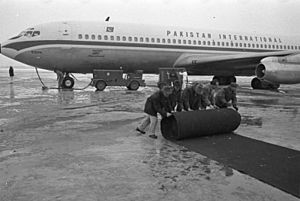
PIA has always flown government officials of Pakistan. It transports the President and Prime Minister on trips to other countries. In the late 1990s, a PIA Boeing 737–300 was used for official visits. Sometimes, the government uses one of PIA's Airbus A320s or a Boeing 777 for official trips.
Charter Flights
PIA operates private charter flights using ATR 42s. These flights go to places like Bhit, Kadanwari, and Sehwan Sharif in Sindh. They also fly to other parts of the country for oil and gas companies. PIA also flies special charter flights for United Nations peacekeeping troops. These flights go to Africa, Eastern Europe, and Asia.
Hajj and Umrah Flights
PIA operates special flights for two months each year for Hajj pilgrims. These flights go to and from Saudi Arabia. PIA used to transport over 100,000 pilgrims each year. However, its fleet became smaller. So, the airline's Hajj quota was reduced to 60,000 to 70,000 pilgrims.
Special Humanitarian Service
A PIA plane carrying medical supplies landed in Afghanistan. This was the first such flight after the Taliban took control. The World Health Organisation thanked Pakistan for providing the Boeing 777 plane. PIA's CEO, Arshad Malik, said it was the airline's "moral responsibility" to help people in Afghanistan.
Awards and Recognition
On September 27, 2024, PIA received Pakistan's first National Tourism Award. This award was for promoting travel and tourism. PIA received it for its great work in promoting travel within Pakistan.
Accidents and Incidents
The airline has had more than 30 aircraft involved in crashes and other events. This includes 20 crashes where people died. There have also been at least eight hijacking incidents involving PIA planes between 1971 and 2017.
- In October 1952, an Orient Airways cargo flight from Karachi to Dacca crashed. One person died.
- On August 3, 1953, a Douglas DC-3 carrying pilgrims crashed after takeoff from Sharjah. One person died. The investigation found the co-pilot lost control.
- In 1956, a Douglas DC-3 crashed into a mountain on February 25. It was a cargo flight from Gilgit to Islamabad. All three crew members died.
- On July 1, 1957, a Douglas DC-3 crashed into the Bay of Bengal. It was flying from Chittagong to Dhaka. All 20 passengers and four crew members died.
- On May 15, 1958, a Convair CV-240 crashed after taking off from Delhi. Four crew members and 21 passengers died. Two people on the ground also died.
- On May 18, 1959, a Vickers Viscount was badly damaged during landing at Islamabad. No one died.
- On August 14, 1959, another Viscount crashed at Karachi International Airport during a training flight. Two of the three people on board died.
- On March 26, 1965, a Douglas DC-3 crashed in mountains near the Lowari Pass. It was flying from Peshawar to Chitral. Four crew members and 18 passengers died.
- Eight weeks later, on May 20, 1965, Flight 705, a Boeing 720, crashed while landing at Cairo International Airport. 121 people died.
- On October 8, 1965, a Fokker F27 Friendship crashed near Patian village. It was a cargo flight from Rawalpindi to Skardu. All four crew members died.
- On February 2, 1966, Flight 17, a Sikorsky S-61 helicopter, crashed in East Pakistan. 23 of the 24 people on board died.
- On August 6, 1970, a Fokker F27 Friendship crashed after taking off from Rawalpindi in stormy weather. All 26 passengers and four crew members died.
- On December 3, 1971, a person tried to hijack a Boeing 720B flight from Paris to Karachi. French security stopped the attempt.
- On December 12, 1971, a Fokker F27 Friendship crashed near the Iranian border. All four people on board died.
- On December 8, 1972, a Fokker F27 Friendship crashed in mountains. It was Flight 631 from Gilgit to Rawalpindi. All 22 passengers and four crew members died.
- On January 20, 1978, a PIA Fokker F27 was hijacked at Karachi. The chairman of PIA was shot while trying to stop the hijacker, but he managed to overpower him.
- On November 26, 1979, Flight 740, a Boeing 707-320C, crashed after takeoff from Jeddah International Airport. 156 people died.
- On March 2, 1981, Flight 326 was hijacked and flown to Kabul. Over 100 passengers were held captive. One passenger was killed.
- On February 4, 1986, a Boeing 747 made a belly landing at Islamabad Airport. It was Flight 300 from Karachi. All 247 passengers and 17 crew members survived.
- On October 23, 1986, a Fokker F27 aircraft crashed near Peshawar Airport. 13 of the 54 people on board died.
- On August 25, 1989, Flight 404, a Fokker F27, disappeared after taking off from Gilgit Airport. All 54 people on board were presumed dead.

- On September 28, 1992, Flight 268, an Airbus A300, crashed while landing at Kathmandu's Tribhuvan International Airport. All 167 people on board died.
- On December 27, 1997, a PIA Boeing 747 from Karachi to London overshot the runway at Dubai airport. No one died.
- On May 25, 1998, Flight 544, a Fokker F27 Friendship, was hijacked. All passengers and crew escaped safely.
- On October 17, 2001, Pakistan International Airlines Flight 231, an Airbus A300, went off the runway during landing at Peshawar. All 205 people on board were safe.
- On March 1, 2004, Pakistan International Airlines Flight 2002, an Airbus A300, had two tires burst during takeoff from King Abdulaziz International Airport. The engines caught fire, and the takeoff was stopped. All 261 passengers and 12 crew survived.
- In March 2005, PIA had several small accidents due to poor maintenance.
- On July 10, 2006, Flight 688, a Fokker F27, crashed in a field after taking off from Multan International Airport. All 41 passengers and four crew members died.
- On September 25, 2010, a PIA Boeing 777-200LR from Toronto to Karachi made an emergency landing in Stockholm. This was due to a false bomb threat.
- On August 31, 2012, an ATR 42–500, Flight 653, landed short of the runway at Lahore. No one died. The aircraft was too damaged to be used again.
- On February 11, 2013, a Boeing 737, Flight 259, had its landing gear collapse during landing at Muscat International Airport. No one died. The aircraft was too damaged to be used again.
- On June 8, 2014, there was an attack on Jinnah International Airport. Several planes were damaged, including a PIA Boeing 747 and an Airbus A310. 36 people died, including the attackers.
- On June 24, 2014, Flight 756, an Airbus A310, was hit by gunfire while landing at Bacha Khan International Airport, Peshawar. One passenger died, and two crew members were injured.
- On December 7, 2016, Flight 661, an ATR 42–500, crashed in Havelian, Pakistan. It was flying from Chitral to Islamabad. All 47 people on board died.
- On May 22, 2020, Flight 8303, an Airbus A320, crashed while landing at Jinnah International Airport, Karachi. 97 people died, and two passengers survived.
- On January 1, 2025, PIA Flight 503 returned to Karachi due to a technical fault. The plane was repaired and is back in service.
- On January 18, 2025, the pilots of flight PK150 from Dammam to Multan landed on the wrong runway. An investigation has started.
- On March 13, 2025, flight PK306 from Karachi to Lahore landed with one tire missing from its landing gear. The missing tire was found at Karachi Airport. An investigation has started.
See also
 In Spanish: Pakistan International Airlines para niños
In Spanish: Pakistan International Airlines para niños
- List of airlines of Pakistan
- Transport in Pakistan


